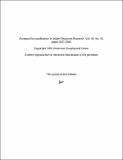Thermal Mediation by Littoral Wetlands and Impact on Lake Intrusion Depth
Author(s)
Andradottir, Hrund O.; Nepf, Heidi
DownloadWRR-thermal mediation.pdf (1.029Mb)
PUBLISHER_POLICY
Publisher Policy
Article is made available in accordance with the publisher's policy and may be subject to US copyright law. Please refer to the publisher's site for terms of use.
Terms of use
Metadata
Show full item recordAbstract
Lake inflow dynamics can be affected by the thermal mediation provided by shallow littoral regions such as wetlands. In this study, wetland thermal mediation is evaluated using a linearized dead-zone model. Its impact on lake inflow dynamics is then assessed by applying the model sequentially to the river reach, wetland, and lake. Our results suggest that littoral wetlands can dramatically alter the inflow dynamics of reservoirs located in small or forested watersheds, for example, by raising the temperature of the inflow during the summer and creating surface intrusions when a plunging inflow would otherwise exist. Consequently, river-borne nutrients, contaminants, and pathogens enter directly into the epilimnion, where they enhance eutrophication and the risk of human exposure. The addition of a littoral wetland has less significant effects in larger watersheds, where the water has already equilibrated with the atmosphere upon reaching the wetland and sun shading is less prominent.
Date issued
2000-03Department
Massachusetts Institute of Technology. Department of Civil and Environmental EngineeringJournal
Water Resources Research
Publisher
American Geophysical Union
Citation
Andradóttir, Hrund Ó., and Heidi M. Nepf. “Thermal mediation by littoral wetlands and impact on lake intrusion depth.” Water Resources Research 36.3 (2000): 725. ©2000 American Geophysical Union.
Version: Final published version
ISSN
0043-1397